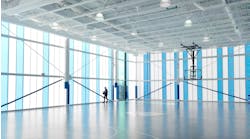Since it’s completion in 2008, the luxury apartment building has sunk 17 inches and tilts 14 inches to the northwest.
(Photo: September 5, 2017, San Francisco, CA - Millennium Tower continues to slowly sink and tilt towards the new Salesforce Tower. Credit: Sundry Photography)
If that didn’t cause major concern for tenants, then the large fissure that was discovered on the high-rise’s 36th floor surely has.
Help BUILDINGS Shape 2019!
What BUILDINGS resources are most valuable to you? What would you like to see us provide?
Please take our short (under 2 minutes) survey - just 5 short questions.
Thank you!
Large Window Crack
According to the San Francisco Chronicle, an apartment owner detected a large crack in his window. Earlier that day, residents also reported hearing a series of creaking noises, followed by a loud pop.
It’s worrisome news for occupants who reside in the 400+ multimillion-dollar condo units spread throughout the skyscraper’s 58 stories, as they already contend with the fact that their building is sinking.
While the Department of Building Inspection has determined the tower is safe to live in, residents have concerns (as you can imagine), including their property investments and susceptibility to earthquakes and fire.
Speaking of fire and inspections: How to Comply with Your Annual Fire Inspection
Millennium Tower Issues
(Photo: November 21, 2009: Millennium Tower completed in 2009 in the South of Market district in downtown San Francisco. Credit: Eric Broder Van Dyke)
When occupants learned about the sinking in 2015, however, apartment values dropped $320,000 on average. Additionally, the building’s rapid shift had led to speculation that it is more vulnerable to an earthquake or fire.
According to a report commissioned by the building’s homeowners association, consultants discovered openings around pipes and ducts in the walls.
If left unsealed without fire-resistant caulking, gaps like these could allow flames to spread more easily throughout the building or smoke could damage the walls.
Furthermore, Millennium Tower sits on land prone to liquefaction, the process by which loose sand and silt behave like a liquid in the event of an earthquake.
To make matters more devastating, multiple scientists believe the San Andreas Fault is on the verge of a devastating earthquake – right where much of California’s major cities lay, including San Francisco.
Who’s Responsible?
Local developers have been arguing over the cause of the building’s sinking and damage since its discovery.
The tower’s developer blames the problem on the construction of the recently-completed Salesforce Transit Center, contending that construction workers pumped too much water out of the ground while the transit center was being built, causing the sand to compress and the tower to settle.
However, the sinking had reportedly started before ground was broke by Transbay Joint Powers Authority (TJPA), who oversaw the center’s development. TJPA asserted the Millennium Tower had already settled 10 inches, well past the original maximum vertical settling prediction of four to six inches over the building’s lifespan.
Some critics even blame city officials for allowing Millennium Partners to anchor the building 80 feet into packed sand rather than 200 feet down into bedrock (a solution for preventing earthquake damage). But the design isn’t all that unusual - the San Francisco Museum of Modern Art and the well-known Embarcadero Center were built on sand instead of bedrock, too.
Regardless of who’s to blame, a solution needs to be found.
Proposed Solution
Earlier this year, engineers did propose anchoring the building to bedrock to stabilize it and prop it back upright. However, the retrofit could cost between $200 and $500 million - the skyscraper cost $350 million to build more than 10 years ago.
Unless engineers follow through on an expensive plan to stabilize the building, structural issues may continue to appear as the tower slowly keeps on shifting.
What Does This Mean For You?
Well, maybe nothing. Maybe everything.
The probability of your facility toppling over like Jenga blocks on the kitchen table is most likely extremely low. Your building may not be anywhere near a fault line threatening to open and swallow it up, but what about fire? That can happen anywhere.
Do your occupants know what to do if there is one? Do you have an emergency plan created and have you distributed it to the right people? Are your sprinkler systems working properly? Can you pass your next fire inspection?
As a manager or owner, you are responsible for what happens inside and around your facility. And if you haven’t thought about this yet, here’s another reason this leaning tower story is relevant to you - your neighboring buildings.
Chances are you’re located in a community of other properties. Do the decisions you make for your building, like updates and retrofits, have an impact on them? Or swap that. Maybe you’re located next to an old building that’s being torn down.
Could the dust in the air from that be affecting your IAQ? Is it possible when the walls come tumbling down, asbestos particles are finding their way into your facility?
Now, don’t go accusing the next owner or facilities manager you see of infecting your occupants’ air supply. That’s not the point.
[Read more on this: Preventing the Next Millennium Tower]
But being aware that your decisions may impact those around you is crucial to a thriving community.
Communicate with your fellow colleagues if you haven’t already.
Could you both benefit from implementing upgrades at the same time? Maybe there are tenant amenities that would benefit both of your occupants, such as splitting the cost of a food truck or bike parking.
Just some things to think about while all eyes remain on that leaning tower in San Francisco.
Katie Downing, Digital Content Specialist for BUILDINGS, contributed to this article.
Two hand-picked articles to read next:




